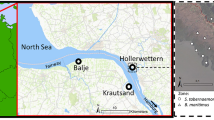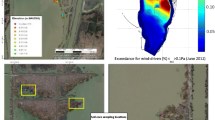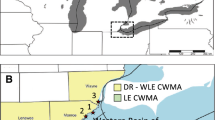Abstract
This multi-year study evaluated the response of invasive Phragmites australis to changes in pore water geochemistry associated with tidal enhancement, alone or in combination with other prescribed management regimes used by the US Fish and Wildlife Service. A pilot study was conducted prior to the treatment experiment that showed a negative correlation between the growth of Phragmites and cation concentrations in a transitional vegetation zone. In the targeted 535-acre brackish-water impoundment (East Pool) where Phragmites dominated, the soil water chemistry was changed by introducing tidal salt water through water control structures in June of 1999. Soil profiles, pH, salinity and cation concentration data in addition to Phragmites height and density data were collected both before and after the treatments were imposed, where possible. It was generally observed that a soil water salinity above ∼28 would be needed to maintain the reduction of Phragmites and to support its replacement by salt marsh species. In the tidal water manipulated experimental macroplots, the soil water salinity changed from 7.1 to 32 on average between 1999 and 2001. The reduction of the average height of Phragmites ranged from 25% to 84% for different treatment combinations, while untreated sites exhibited a slight increases in height. The reduction in average live density ranged from 51% to 87% for different treatment combinations. The greatest reduction of Phragmites density and height resulted when tidal enhancement was followed by a prescribed burn in the winter. Also, significant negative correlations were observed between Phragmites height and the main cations associated with tidal salt water including Mg2+, Na+ and K+ and to a lesser extent Ca2+. pH did not change drastically with the introduction of tidal water over the period of 1999–2001 and did not appear to play a significant role in changing the growth of Phragmites. A reduction of soil adhesiveness associated with the decay of Phragmites roots was observed after a two month period in 2001 when plants were submerged in standing water. This points to the need to maintain tidal exchange to promote a gradual transition from a Phragmites-dominated system to a Spartina-dominated system. Towards the end of the growing season in 2001, Spartina patens and Distichlis spicata had begun to ramify into the center of the island patches.
Similar content being viewed by others
References
Armstrong J, Armstrong W (1999) Phragmites die-back: toxic effects of propionic, butyric, and caproic acids in relation to pH. New Phytol 142:201–208
Armstrong J, Afreen-Zobayed F, Armstrong W (1996) Phragmites die-back: sulphide- and acetic acid-induced bud and root death, lignifications, and blockages within aeration and vascular systems. New Phytol 134:601–614
Bertness MD (1985) Fiddler crab regulation of Spartina alterniflora production on a New England salt marsh. Ecology 66:1042–1055
Bertness MD (1992) The ecology of a New England salt marsh. Am Sci 80:260–268
Bongiorno SF, Trautman JR, Steinke TJ, Kawa-Raymond S, Warner D (1984) A study of restoration in Pine Creek Salt Marsh, Fairfield, Connecticut. In: Webb FJ (ed) Proceedings of the 11th annual conference in wetlands restoration and creation. Hillsborough Community College, Tampa, FL.Elzinga, C.L., Salzar, D.W.
Boone J, Furbish E, Turner K (1987) Control of Phragmites communis: results of burning, cutting, and covering with plastic in a North Carolina marsh. CPSU technical report 41, National Park Service, 15 pp
Brady NC, Weil RR (2004) The nature and properties of soils, 2nd edn. Prentice Hall, Upper Saddle River, New Jersey
Chambers RM (1997) Porewater chemistry associated with Phragmites and Spartina in a Connecticut tidal marsh. Wetlands: The J Soc Wetland Sci 17:360–367
Chambers RM, Meyerson LA, Saltonstall K (1999) Expansion of Phragmites australis into tidal wetlands of North America. Aq Bot 64:261–273
Cross DH, Fleming KL (1989) Control of Phragmites or common reed. USFWS Leaflet 13.4.12
Elzinga CL, Salzar DW, Willoughby JW (1998) Measuring and monitoring plant populations. BLM Tech Ref 1730–1731, 477 pp
Gries C, Kappen L, Losch R (1990) Mechanism of flood tolerance in reed, Phragmites australis (Cav.) Trin. ExSteudel. New Phytol 114:589–593
Haslam SM (1971) The development and establishment of young plants of Phragmites communis Trin. Ann Bot 35:1059–1072
Haslam SM (1972) Phragmites communis Trin. biological flora British Isles. J Ecol 60:585–610
Hellings SE, Gallagher JL (1992) The effects of salinity and flooding on Phragmites australis. J Appl Ecol 29:41–49
Hinkle RL, Mitch WJ (2005). Salt Marsh vegetation recovery at salt hay farm wetland restoration sites on Delaware Bay. Ecol Eng 25:240–251
Hocking PJ, Finlayson CM, Chick AJ (1983) The biology of Australian weeds. Phragmites australis (Cav.) Trin. ex Steud. J Aust Inst Agr Sci 12:123–132
Jiraungkoorskul W, Upatham ES, Kruatrachue M, Sahaphong S, Vichasri-Grams S, Pokethitiyook P (2003) Biochemical and histopathological effects of glyphosate herbicide on Nile tilapia (Oreochromis niloticus). Environ Toxicol 18:260–267
Kay S (1995) Efficacy of wipe-on applications of glyphosate and imazapyr on common reed in aquatic sites. J␣Aqua Manage 33:25–26
Langmuir D (1997) Aquatic environmental geochemistry. Prentice Hall, Inc., UK
Lissner J, Schierup H-H (1997) Effects of salinity on the growth of Phragmites australis. Aqua Bot 55:247–260
Marks M, Lapin B, Randall J (1994) Phragmites australis (P. communis): threats, management, and monitoring. Nat Areas J 14:285
Marrs RH, Frost AJ, Plant RA, Lunnis P (1993) Determination of buffer zones to protect seedlings of non-target plants from the of glyphosate spray drift. Agr Ecosyst Environ 45:283–293
Neuhaus D, Kuhl H, Kohl JG (1993) Investigation on the genetic diversity of Phragmites stands using genomic fingerprinting. Aqua Bot 45:357–364
Ponnamperuma FN (1979) The chemistry of submerged soils. Adv Agron 24:29–96
Riemer DN (1973) Effects of rate, spray volume, and surfactant on the control of Phragmites with glyphosate. Proc Annu Meet Northeastern Weed Sci Soc 27:101–104
Riemer DN (1976) Long-Term Effects of Glyphosate Applications to Phragmites. J Aqua Plant Manage 14:39–43
Roman CT, Niering WA, Warren RS (1984) Salt marsh vegetation change in response to tidal restriction. Environ Manage 8:141–150
Saltonstall K (2002) Cryptic invasion by a non-native genotype of the common reed, Phragmites australis, into North America. PNAS 99(4):2445–2449
Sun H, Browne KK, Husch J (1999) Pore water geochemistry in a transition zone of Spartina to Phragmites in a tidal marsh in Stone Harbor, New Jersey. Geol Soc Am Abst with Prog. 31:2
Thompson DJ, Shay JM (1985) The effects of fire on Phragmites australis in the Delta Marsh, Manitoba. Can J Bot 63:1864–1869
Thompson DJ, Shay JM (1989) First-year response of a Phragmites marsh community to seasonal burning. Can J Bot 67:1448–1455
Tiner R (1997) Managing common reed (Phragmites australis) in Massachusetts—an overview of the Species and Control Techniques. Mass. Wetlands Restoration and Banking Program. Executive Office of Environmental Affairs. 100 Cambridge St., Boston, MA 02202
Tscharntke T (1989) Attach by stem-boring moth increases susceptivility of Phragmites australis to gall-making by a midge: mechanisms and effects of midge population dynamics. Oikos 55:92–100
Tucker GC (1990) The genera of Arundinoideae (Gramineae) in the southeastern United States. J Arnold Arboretum 71:145–177
Van der Toorn J, Mook JH (1982) The influence of environmental factors and management on stands of Phragmites australis. I. Effect of burning, frost and insect damage on shoot density and shoot size. J Appl Ecol 19:477–500
Vasquez EA, Glenn EP, Brown JJ, Guntenspergen GR, Nelson SG (2005) Salt tolerance underlies the cryptic invasion of North American salt marshes by an introduced haplotype of the common reed Phragmites australis (Poaceae). Mar Ecol Prog Ser 298:1–8
Weis JS, Weis P (2003) Is the invasion of the common reed, Phragmites australis, into tidal marshes of the eastern US an ecological disaster? Mar Pollut Bull 46:816–820
Windham L, Lathrop RG Jr (1999) Effects of Phragmites australis (common reed) invasion on aboveground biomass and soil properties in a brackish tidal marsh of the Mullica River, New Jersey. Estuaries 22:927–935
Zar JH (1984) Biostatistical analysis. Prentice Hall, New␣Jersey
Acknowledgements
The authors want to thank Steve Atzert, Tracy Casselman, Amy Jones, and Kelly Hogan from EBF Refuge for their help with the field work, support and coordination of the project. We want to thank Jonathan Husch of Rider University for his help with the ICP instrument. We also thank Frank Petrino, for helping with part of data entry and lab work. It is with the help from these people and financing from the EBF Refuge and Rider University that we were able to accomplish so much on this project.
Author information
Authors and Affiliations
Corresponding author
Rights and permissions
About this article
Cite this article
Sun, H., Brown, A., Coppen, J. et al. Response of Phragmites to environmental parameters associated with treatments. Wetlands Ecol Manage 15, 63–79 (2007). https://doi.org/10.1007/s11273-006-9013-7
Received:
Accepted:
Published:
Issue Date:
DOI: https://doi.org/10.1007/s11273-006-9013-7




